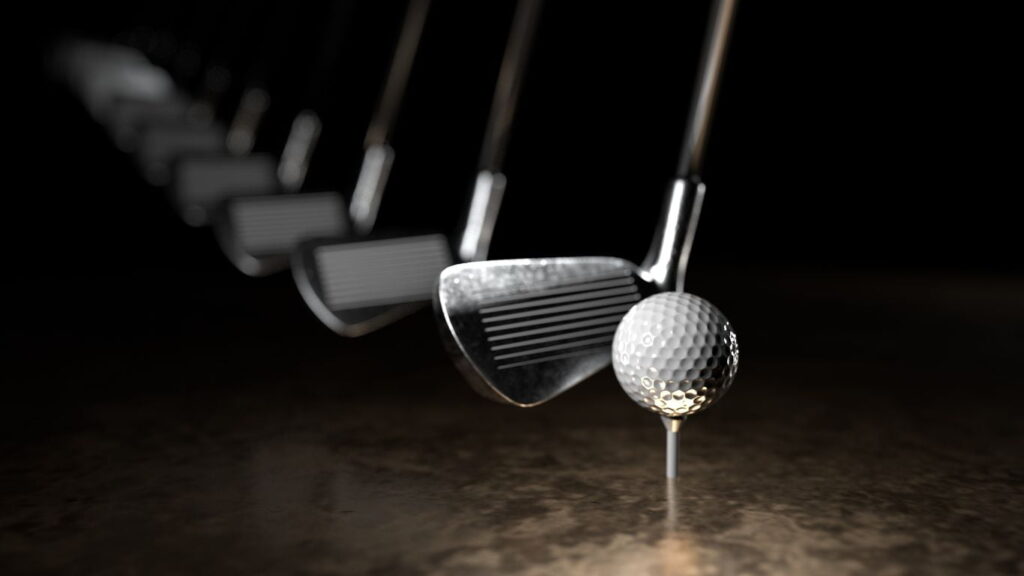Golf is a challenging and rewarding game, but even the most experienced players can struggle with topping the ball. Topping the ball is a common problem among amateur golfers, and it can be incredibly frustrating and embarrassing when it happens. Fortunately, there are several simple drills that you can use to help stop topping the golf ball and improve your game.
In this article, we’ll cover five easy-to-follow drills that can help you to understand on how to stop topping the golf ball. These drills cover a range of areas, including tee height adjustment, weight shift, ball position, follow through, and effective practice routines. Whether you’re a beginner or a seasoned player, these drills can help you develop a more consistent swing and avoid topping the ball in the future.
By taking the time to practice these drills, you can gain a better understanding of your swing and how it affects your shots. With patience and persistence, you can overcome the embarrassment of topping the golf ball and enjoy more success on the golf course again. So, let’s get started with the first drill: tee height adjustment.

Drill 1: Tee Height Adjustment
Adjusting your tee height is one of the most effective ways to stop topping the golf ball. The height of the tee can have a significant impact on the angle of your swing and the quality of your shot.
If the tee is too high or too low, it can cause you to make contact with the top of the golf ball, resulting in a weak shot that doesn’t travel far.
Here are step-by-step instructions on how to adjust your tee height for different clubs and types of club head:
1. Determine the ideal tee height for your driver
The ideal tee height for your driver should be so that the golf ball sits just above the top of the club head when the clubface is resting on the ground.
2. Adjust the tee height for your fairway woods and hybrids
For fairway woods and hybrids, you should use a tee that is slightly lower than the tee you used for your driver. This will help you achieve the right launch angle and maximize distance.
3. Adjust the tee height for your irons
For irons, you should tee the golf ball up so that it is just above the grass. This will help you achieve the right angle of approach and make solid contact with the ball.
It’s important to note that tee height can also be adjusted for different types of golf shots too. For example, if you’re trying to hit a low, driving shot, you may want to tee the ball lower than usual.
If you’re trying to hit a high, sweeping shot, you may want to tee the ball higher than usual.
Here are some tips to ensure proper tee height for different types of shots:
1. High tee for high shots
If you’re trying to hit a high shot, tee the ball up higher than usual. This will help you achieve the right launch angle and get the ball up in the air.
2. Low tee for low shots
If you’re trying to hit a low shot, tee the ball up lower than usual. This will help you achieve a lower launch angle and keep the ball closer to the ground.
3. Tee height for punch shots
For punch shots, tee the golf ball up lower than usual and use a shorter club. This will help you achieve a lower ball flight and more control.
4. Tee height for driver accuracy
To improve your accuracy with the driver, tee the ball up slightly lower than usual. This will help you make more solid contact with the ball and reduce the chances of hitting it too high or too low.
In addition to adjusting your tee height for different clubs and types of shots, there are a few other tips to keep in mind:
- Check your equipment
- Make sure you’re using the right tees for your clubs and that they’re in good condition. A worn or damaged tee can affect your shot quality.
- Practice with different tee heights
- Take some time to practice with different tee heights to get a feel for how it affects your shots. This can help you make the right adjustments on the course.
- Experiment with different clubs
- Try using different clubs off the tee to see which one works best for you. You may find that using a fairway wood or hybrid instead of a driver can help you achieve better results.
By taking the time to adjust your tee height and experiment with different clubs and types of shots, you can improve your ability to make solid contact with the golf ball and avoid topping it.
It’s important to remember that tee height is just one factor that can affect your shot quality, but it’s a crucial one that should not be overlooked.
Incorporate tee height adjustment into your practice routine and watch your golf game improve.
Drill 2: Weight Shift

Another common cause of topping the golf ball is improper weight shift. If you’re not shifting your weight properly during your swing, it can cause you to hit the ball cleanly top of the ball and produce weak shots.
Here are step-by-step instructions on how to improve your weight shift:
1. Start with proper setup
Before you swing, make sure you’re starting with a proper setup. Your feet should be shoulder-width apart, and your weight should be evenly distributed.
2. Shift your weight from lead foot to your back foot
As you start your backswing, shift your weight from left shoulder to your back foot. This will help you create a more powerful swing and avoid topping the golf ball.
3. Shift your weight to your front foot
As you start your downswing, shift your weight to your front foot. This will help you create a more downward angle of attack and make solid contact with the ball.
4. Maintain balance throughout the entire swing
It’s important to maintain balance throughout your swing. Avoid swaying or shifting too much during your backswing or downswing.
5. Use drills to improve weight shift
There are several drills you can use to improve your weight shift, including practicing with a weight shift trainer or using alignment sticks to help you maintain proper balance.
It’s important to note that weight shift can also be affected by your stance and posture. Make sure you’re standing tall and keeping your spine straight throughout your swing.
Avoid slouching or hunching over, as this can affect your weight shift and lead to topping the ball.
Here are some tips to help you maintain correct posture address position and stance:
1. Keep your feet grounded
Make sure your feet are firmly planted on the ground throughout your swing. This will help you maintain proper balance and avoid swaying or shifting too much.
2. Keep your head steady on your spine straight
Keep your spine straight and avoid slouching or hunching over. This will help you maintain proper posture and avoid topping the ball.
3. Relax your arms and shoulders
Avoid tensing up your arms and shoulders during your swing. This can affect your weight shift and lead to topping the golf ball.
4. Practice with a mirror
Use a mirror to help you maintain proper posture and stance during your swing. This can help you identify any areas that need improvement.
By practicing weight shift and maintaining proper posture and stance, you can improve your ability to make solid contact with the ball and avoid topping it.
It’s important to remember that weight shift is just one factor that can affect your own golf shot quality, but it’s a crucial one that should not be overlooked.
Incorporate weight shift drills into your practice routine and watch your game improve.
Drill 3: Ball Position

The position of the ball on the tee can also impact your ability to avoid topping the ball. When the ball is too far forward or too far back, it can cause you to make contact with the top of the ball instead of hitting it solidly.
Here are step-by-step instructions on how to adjust your golf ball alignment:
1. Determine the ideal ball position for your driver
For your driver, the ball should be positioned just inside your front heel. This will help you achieve the right angle of approach and maximize distance.
2. Adjust the ball position for your fairway woods and hybrids
For fairway woods and hybrids, the ball should be positioned slightly further back in your stance than it is for your driver. This will help you achieve the right launch angle and maximize distance.
3. Adjust the ball position for your irons
For irons, the ball should be positioned slightly further back in your stance than it is for fairway woods and hybrids. This will help you achieve a more downward angle of attack and make solid contact with the golf ball.
It’s important to note that ball location can also be adjusted for different types of shots. For example, if you’re trying to hit a low punch shot, you may want to position the ball further back in your stance.
If you’re trying to hit a high, sweeping shot, you may want to position the ball further forward in your stance.
Here are some tips to ensure proper ball position for different types of shots:
1. High ball tee for high shots
If you’re trying to hit a high shot, position the ball slightly further forward in your stance. This will help you achieve the right launch angle and get the golf ball up in the air.
2. Low ball tee for low shots
If you’re trying to hit a low shot, position the ball slightly further back in your stance. This will help you achieve a lower launch angle and keep the ball closer to the ground.
3. Ball position for punch shots
For punch shots, position the ball further back in your stance and use a shorter club. This will help you achieve a lower ball flight and more control.
4. Position for accuracy
To improve your accuracy, position the ball slightly further back in your stance. This will help you make more solid contact with the golf ball and reduce the chances of topping it.
In addition to adjusting your ball position for different clubs and types of shots, there are a few other tips to keep in mind:
1. Check your equipment
Make sure you’re using the right ball for your clubs and that they’re in good condition. A worn or damaged ball can affect your shot quality.
2. Practice with different ball positions
Take some time to practice with different ball positions to get a feel for how it affects your shots. This can help you make the right adjustments on the course.
3. Experiment with different clubs
Try using different clubs for different types of shots to see which one works best for you. You may find that using a fairway wood or hybrid instead of an iron can help you achieve better results
By taking the time to adjust your golf ball position and experiment with different clubs and types of shots, you can improve your ability to make solid contact with the ball and avoid topping it.
It’s important to remember that ball position is just one factor that can affect your shot quality, but it’s a crucial one that should not be overlooked.
Drill 4: Follow Through

The follow-through is an essential part of your golf swing and can impact your shot quality. If you’re not following through properly, it can cause you to hit the top of the ball and produce weak shots.
Here are step-by-step instructions on how to improve your follow-through:
1. Start with proper setup
Before you swing, make sure you’re starting with a proper setup. Your feet should be shoulder-width apart, and your weight should be evenly distributed.
2. Keep your eye on the golf ball
As you swing, keep your eye on the ball and maintain your focus. This will help you make solid contact with the ball and avoid topping it.
3. Swing through the ball
As you make contact with the ball, continue your swing and follow through. This will help you achieve the right angle of approach and maximize distance.
4. Maintain balance throughout the swing
It’s important to maintain balance throughout your golf swing. Avoid swaying or shifting too much during your backswing or downswing.
5. Use drills to improve follow-through
There are several drills you can use to improve your follow-through, including practicing with a mirror or using an alignment stick to help you maintain proper balance.
It’s important to note that follow-through can also be affected by your grip and club selection. Make sure you’re using the right grip for your swing and selecting the right club for the shot you’re trying to make.
Here are some tips to help you maintain proper grip and golf club selection:
1. Choose the right grip
Make sure you’re using the right grip for your swing. A grip that’s too tight or too loose can affect your follow-through and lead to topping the golf ball.
2. Choose the right club
Select the right club for the shot you’re trying to make. Using the wrong club can affect your follow-through and lead to topping the ball.
3. Practice with a mirror
Use a mirror to help you maintain proper follow-through during your swing. This can help you identify any areas that need improvement.
4. Experiment with different clubs
Try using different clubs for different types of shots to see which one works best for you. You may find that using a fairway wood or hybrid instead of an iron can help you achieve better results.
By practicing follow-through and maintaining proper grip and club selection, you can improve your ability to make solid contact with the ball and avoid topping it.
It’s important to remember that follow-through is just one factor that can affect your shot quality, but it’s a crucial one that should not be overlooked.
Incorporate follow-through drills into your practice routine and watch your golf game improve.
Drill 5: Tempo

Tempo is another important factor that can affect your ability to avoid topping golf shots with the golf ball. If you’re swinging too quickly or too slowly, it can cause you to make contact with the top of the ball and produce weak shots.
Here are step-by-step instructions on how to improve your golf swing tempo:
1. Start with proper setup
Before you swing, make sure you’re starting with a proper setup. Your feet should be shoulder-width apart, and your weight should be evenly distributed.
2. Establish a rhythm
As you start your backswing, establish a rhythm that feels comfortable and natural to you. This will help you maintain a consistent tempo throughout your golf swing.
3. Swing smoothly
As you swing, focus on making a smooth, fluid motion. Avoid jerky or sudden movements, as this can affect your tempo and lead to topping the ball.
4. Maintain balance throughout the swing
It’s important to maintain balance throughout your swing. Avoid swaying or shifting too much during your backswing or downswing.
5. Use drills to improve tempo
There are several drills you can use to improve your tempo, including using a metronome or counting out your swing in a steady rhythm.
It’s important to note that the tempo of golf swings can also be affected by your mental state and approach to the game.
Make sure you’re relaxed and focused during your swing and not rushing or forcing your shot.
Here are some tips to help you maintain a relaxed and focused mental state:
1. Breathe deeply
Take deep breaths before your swing to help you relax and stay focused. This can help you maintain a consistent tempo and avoid topping the ball.
2. Visualize your shot
Visualize your shot before you play golf and swing to help you stay focused and avoid rushing your swing.
3. Stay positive
Stay positive and confident during your full golf and practice swing. Avoid getting frustrated or discouraged, as this can affect your tempo and lead to topping the ball.
4. Practice mindfulness
Practice mindfulness techniques like meditation or yoga to help you stay relaxed and focused during your swing.
By practicing tempo and maintaining a relaxed and focused mental state, you can improve your ability to make solid contact with the ball and avoid topping it.
It’s important to remember that tempo is just one factor that can affect your shot quality, but it’s a crucial one that should not be overlooked. Incorporate tempo drills into your practice routine and watch your golf game improve.
Stay Positive and Keep Practicing!

In conclusion, topping the golf ball can be a frustrating experience for any golfer.
However, by incorporating these five simple drills into your practice routine, you can improve your ability to make solid contact with the ball and avoid topping it.
To recap, here are the five drills that can help you stop topping the golf ball:
1. Addressing the tee height
Make sure you’re using the right tee height for your club and make good golf shots.
2. Weight shift
Improve your weight shift to create more powerful golf swings and avoid topping the ball.
3. Ball position
Adjust your ball position to achieve the right launch angle and maximize distance.
4. Follow-through
Focus on your follow-through to maintain proper swing mechanics and avoid topping the ball.
5. Tempo
Maintain a consistent tempo to avoid rushing your swing and hitting the top of the ball.
By incorporating these drills into your practice routine and focusing on proper swing mechanics and mental approach, you can improve your golf game and avoid the frustration of topping the ball.
Remember to start with a proper setup, maintain balance throughout your swing, and use the right grip and club selection for your golf shot.
With consistent practice and patience, you can overcome topping the golf ball and enjoy a more successful and enjoyable golf game.
Still struggling?

Remember, improving your golf game takes time and practice. Don’t get discouraged if you don’t see results right away. Continue to focus on proper technique and incorporate these drills into your practice routine.
If you’re still struggling with topping the ball after practicing these drills, it may be time to consider seeking professional help. A golf instructor can provide personalized feedback and guidance on how to improve your swing and avoid topping the ball.
They can also help you identify any underlying issues that may be contributing to your topping problem.
Don’t be afraid to ask for help and seek out professional instruction. With the right guidance and practice, you can overcome topping the ball and enjoy a more successful and satisfying golf game.
Keep practicing, stay positive, and don’t give up. You got this!







